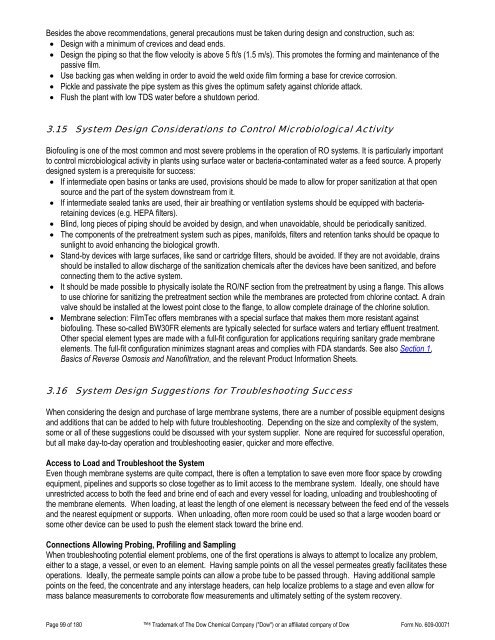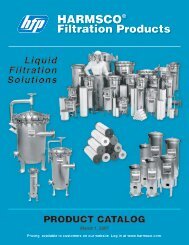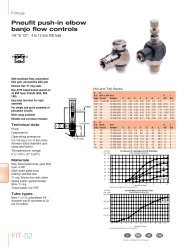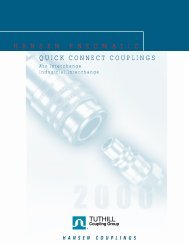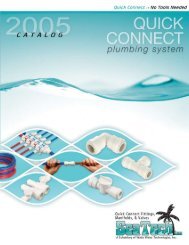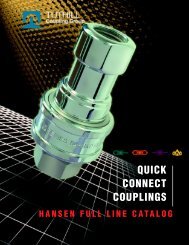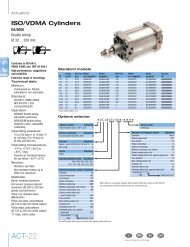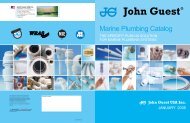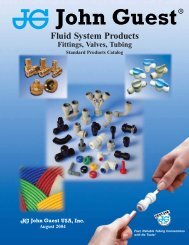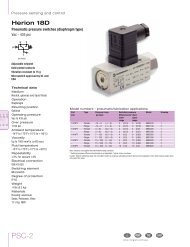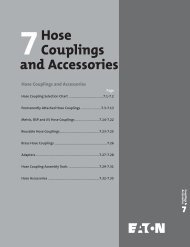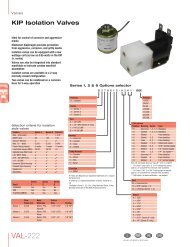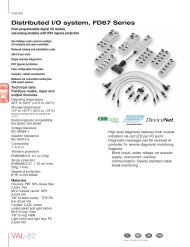3.14 Materials of Construction, Corrosion ControlFrom a corrosion point of view, a very harsh environment prevails in an RO water desalination plant. Hence the materials ofconstruction must possess a certain degree of corrosion resistance. This is true for both the exterior parts exposed tospillage and a humid and saline atmosphere as well as for the interior of the system exposed to the wide variety of waterstreated.Although not to be underestimated, the control of exterior corrosion can usually be overcome by using a surface coating(painting, galvanizing, etc.) on materials likely to corrode (mild steel, cast iron, etc.) and by establishing a maintenanceprogram involving periodical flush down and cleaning, repair of leaks, etc.Selecting materials of construction for the interior wetted system is a far more complicated task. Apart from being compatiblewith the pressures, vibrations, temperatures, etc., existing in an RO system, the materials must also be able to withstandpotential corrosion attacks caused by the high chloride content of the feed water and concentrate stream, the aggressiveproduct water and the chemicals used for applications such as membrane cleaning.Application of nonmetallic materials such as plastics, fiberglass, etc., are widely used for preventing corrosion and chemicalattacks as well in the low-pressure (< 145 psi/10 bar) part of the RO system as in the RO elements and pressure vessels.However, it is usually necessary to use metals for the high-pressure (145–1,000 psi/10–70 bar) parts such as pumps, pipingand valves. Carbon and low alloy steels do not have sufficient corrosion resistance, and their corrosion products can foul themembranes.Lined piping is usually not a realistic alternative because of the often compact piping design and relatively great amount ofconnections and fittings needed. Al-bronze can be an alternative for pumps etc., but the risk of erosion corrosion andchemical attacks must be taken into account. The most relevant material to be used for the high-pressure parts is stainlesssteel.The basic advantage with stainless steel is that it is very resistant to general corrosion and erosion corrosion. Stainless steelis rarely attacked by galvanic corrosion, but it will influence the attack on the other metal in a two-metal couple (e.g. copper,brass, etc.). Stress corrosion cracking of stainless steels in media containing chloride rarely occurs below 158°F (70°C) so itdoes not need to be considered in an RO desalination plant.Unfortunately, some stainless steels are prone to pitting and crevice corrosion in the waters occurring in an RO plant. Pittingmeans localized attacks that result in holes in the metal. Pitting occurs where the passive film formed by chromium oxidesbreaks and chlorides can attack the bare metal. Crevice corrosion is pitting associated with small volumes of stagnant watercaused by holes, gasket surfaces, deposits, and crevices under bolts, etc. In order to avoid pitting and crevice corrosion inthe RO water desalination plant the following recommendations can be given:RO Plants with Concentrate Stream TDS below 7,000 ppmStainless steel type AISI 316 L with
Besides the above recommendations, general precautions must be taken during design and construction, such as:• Design with a minimum of crevices and dead ends.• Design the piping so that the flow velocity is above 5 ft/s (1.5 m/s). This promotes the forming and maintenance of thepassive film.• Use backing gas when welding in order to avoid the weld oxide film forming a base for crevice corrosion.• Pickle and passivate the pipe system as this gives the optimum safety against chloride attack.• Flush the plant with low TDS water before a shutdown period.3.15 System Design Considerations to Control Microbiological ActivityBiofouling is one of the most common and most severe problems in the operation of RO systems. It is particularly importantto control microbiological activity in plants using surface water or bacteria-contaminated water as a feed source. A properlydesigned system is a prerequisite for success:• If intermediate open basins or tanks are used, provisions should be made to allow for proper sanitization at that opensource and the part of the system downstream from it.• If intermediate sealed tanks are used, their air breathing or ventilation systems should be equipped with bacteriaretainingdevices (e.g. HEPA filters).• Blind, long pieces of piping should be avoided by design, and when unavoidable, should be periodically sanitized.• The components of the pretreatment system such as pipes, manifolds, filters and retention tanks should be opaque tosunlight to avoid enhancing the biological growth.• Stand-by devices with large surfaces, like sand or cartridge filters, should be avoided. If they are not avoidable, drainsshould be installed to allow discharge of the sanitization chemicals after the devices have been sanitized, and beforeconnecting them to the active system.• It should be made possible to physically isolate the RO/NF section from the pretreatment by using a flange. This allowsto use chlorine for sanitizing the pretreatment section while the membranes are protected from chlorine contact. A drainvalve should be installed at the lowest point close to the flange, to allow complete drainage of the chlorine solution.• Membrane selection: <strong>FilmTec</strong> offers membranes with a special surface that makes them more resistant againstbiofouling. These so-called BW30FR elements are typically selected for surface waters and tertiary effluent treatment.Other special element types are made with a full-fit configuration for applications requiring sanitary grade membraneelements. The full-fit configuration minimizes stagnant areas and complies with FDA standards. See also Section 1,Basics of Reverse Osmosis and Nanofiltration, and the relevant Product Information Sheets.3.16 System Design Suggestions for Troubleshooting SuccessWhen considering the design and purchase of large membrane systems, there are a number of possible equipment designsand additions that can be added to help with future troubleshooting. Depending on the size and complexity of the system,some or all of these suggestions could be discussed with your system supplier. None are required for successful operation,but all make day-to-day operation and troubleshooting easier, quicker and more effective.Access to Load and Troubleshoot the SystemEven though membrane systems are quite compact, there is often a temptation to save even more floor space by crowdingequipment, pipelines and supports so close together as to limit access to the membrane system. Ideally, one should haveunrestricted access to both the feed and brine end of each and every vessel for loading, unloading and troubleshooting ofthe membrane elements. When loading, at least the length of one element is necessary between the feed end of the vesselsand the nearest equipment or supports. When unloading, often more room could be used so that a large wooden board orsome other device can be used to push the element stack toward the brine end.Connections Allowing Probing, Profiling and SamplingWhen troubleshooting potential element problems, one of the first operations is always to attempt to localize any problem,either to a stage, a vessel, or even to an element. Having sample points on all the vessel permeates greatly facilitates theseoperations. Ideally, the permeate sample points can allow a probe tube to be passed through. Having additional samplepoints on the feed, the concentrate and any interstage headers, can help localize problems to a stage and even allow formass balance measurements to corroborate flow measurements and ultimately setting of the system recovery.Page 99 of 180 ® Trademark of The Dow Chemical <strong>Company</strong> ("Dow") or an affiliated company of Dow Form No. 609-00071
- Page 1 and 2:
DowWater SolutionsFILMTEC Reverse O
- Page 3:
2.6 Biological Fouling Prevention .
- Page 7 and 8:
1. Basics of Reverse Osmosis and Na
- Page 9 and 10:
Nanofiltration (NF)Nanofiltration r
- Page 11 and 12:
How to Use Reverse Osmosis and Nano
- Page 13 and 14:
1.4 Membrane DescriptionThe FILMTEC
- Page 15 and 16:
Membrane systems are typically desi
- Page 17 and 18:
1.8 Element CharacteristicsFILMTEC
- Page 19 and 20:
2. Water Chemistry and Pretreatment
- Page 21 and 22:
SeawaterSeawater with TDS of 35,000
- Page 23 and 24:
Table 2.5 Water analysis for RO/NFS
- Page 25 and 26:
Table 2.7 Solubility products of sp
- Page 27 and 28:
In this process, only Ca 2+ , Ba 2+
- Page 29 and 30:
For the concentration ranges presen
- Page 31 and 32:
The conditions for CaCO 3 scale con
- Page 33 and 34:
Figure 2.3 Langelier saturation ind
- Page 35 and 36:
These computations have been descri
- Page 37 and 38:
Figure 2.5 “K” versus ionic str
- Page 39 and 40:
Figure 2.6 Ksp for CaSO 4 versus io
- Page 41 and 42:
2.4.6 Calcium Fluoride Scale Preven
- Page 43 and 44:
Figure 2.8 K sp for SrSO 4 versus i
- Page 45 and 46:
2.4.7 Silica Scale PreventionDissol
- Page 47 and 48: Table 2.10 Solubility of SiO 2 vers
- Page 49 and 50: 2.4.8 Calcium Phosphate Scale Preve
- Page 51 and 52: Table 2.9 Various fouling indicesIn
- Page 53 and 54: Frequent shutdowns and start-ups sh
- Page 55 and 56: If the differential pressure across
- Page 57 and 58: 1. Intake (surface) or well, before
- Page 59 and 60: or combined residual chlorine (CRC)
- Page 61 and 62: 2.6.5 DBNPADBNPA (2,2, dibromo-3-ni
- Page 63 and 64: 2.6.11 Use of Fouling Resistant Mem
- Page 65 and 66: 2.11 Treatment of Feedwater Contain
- Page 67 and 68: 2.13 Summary of Pretreatment Option
- Page 69 and 70: 26. Handbook of Industrial Membrane
- Page 71 and 72: Table 3.1 System design information
- Page 73 and 74: 3.2 Batch vs. Continuous ProcessAn
- Page 75 and 76: 3.4 Single-Stage SystemIn a single-
- Page 77 and 78: The apparent salt passage of the sy
- Page 79 and 80: Instead of having a separate high-p
- Page 81 and 82: 3.9.1 Membrane System Design Guidel
- Page 83 and 84: In Table 3.6, the small commercial
- Page 85 and 86: Table 3.8 Number of stages of a sea
- Page 87 and 88: 3.11 System Performance Projection3
- Page 89 and 90: 3.11.2 Design Equations and Paramet
- Page 91 and 92: Table 3.10 Design equations for pro
- Page 93 and 94: 3.11.3 Comparing Actual Performance
- Page 95 and 96: The high-pressure concentrate is fe
- Page 97: If the product water from an RO sys
- Page 101 and 102: 4. Loading of Pressure VesselsThis
- Page 103 and 104: The process of shimming is performe
- Page 105 and 106: 4.5.2 Summary of Large Element Inte
- Page 107 and 108: 5. System Operation5.1 Introduction
- Page 109 and 110: 5.2.3 Start-Up SequenceProper start
- Page 111 and 112: 5.2.4 Membrane Start-Up Performance
- Page 113 and 114: 5.5.3 SeawaterIn principle, the ope
- Page 115 and 116: Table 5.1 Reverse osmosis operating
- Page 117 and 118: A. Normalized Permeate FlowQS=ΔPsP
- Page 119 and 120: For the operating conditions we hav
- Page 121 and 122: 4. During recirculation of cleaning
- Page 123 and 124: 2. The cleaning pump should be size
- Page 125 and 126: 6.7 Effect of pH on Foulant Removal
- Page 127 and 128: Cleaning ProcedureThere are seven s
- Page 129 and 130: If the organic fouling is the resul
- Page 131 and 132: There are two factors that greatly
- Page 133 and 134: 7. Handling, Preservation and Stora
- Page 135 and 136: 7.4 Preservation of RO and NF Syste
- Page 137 and 138: If the normalized actual performanc
- Page 139 and 140: 8.3.3 Localization of High Solute P
- Page 141 and 142: Figure 8.2 Permeate probing apparat
- Page 143 and 144: 8.4.5 Performance TestThe standard
- Page 145 and 146: 8.5.1.1 Low Flow and Normal Solute
- Page 147 and 148: . Metal Oxide FoulingMetal oxide fo
- Page 149 and 150:
. Organic FoulingThe adsorption of
- Page 151 and 152:
8.5.3 High Pressure DropHigh differ
- Page 153 and 154:
In case of fullfit or heat sanitiza
- Page 155 and 156:
Breakpoint chlorinationBreak tankBr
- Page 157 and 158:
FeedThe input solution to a treatme
- Page 159 and 160:
Milligram per litre (mg/L)Mixed-bed
- Page 161 and 162:
SBS Sodium bisulfite, NaHSO 3.Scale
- Page 163 and 164:
9.2 Specific Conductance of Sodium
- Page 165 and 166:
Figure 9.1 Conductivity of ionic so
- Page 167 and 168:
9.6 Temperature Correction FactorTa
- Page 169 and 170:
9.9 Osmotic Pressure of Sodium Chlo
- Page 171 and 172:
Details - TestEquipment andSpecific
- Page 173 and 174:
satisfactory for such a determinati
- Page 175 and 176:
case for almost all tested biocides
- Page 177 and 178:
9.12 Key Word IndexAbrasion - 150 B
- Page 179 and 180:
Positive displacement pump - 95 Shu


